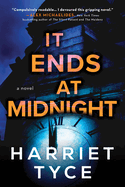
This may be some sort of record. The innocent-person-wrongly-accused story, the courtroom drama, the revenge plot: It Ends at Midnight by Harriet Tyce accommodates all three classic crime novel approaches while also incorporating two mainstays of the contemporary thriller--the social media scandal and the #MeToo reckoning. It sounds like a feat of narrative engineering, but Tyce makes it work.
Sylvie Munro, a London barrister turned deputy district judge, has one ambition: "the red sash and purple robes of the Crown Court judge." As It Ends at Midnight begins, she has won an appeal--"[j]ust what I needed for my judge's application"--and is luxuriating in her romance with her caterer boyfriend of six months. "There's a glowing future ahead," Sylvie thinks. In fact, well into the novel, readers would be under the impression that Sylvie hasn't a care in the world--if the chapters she narrates weren't intercut with accounts of a grisly crime committed in Edinburgh. The novel's mystery isn't just what happened; it's also who the victims are.
Tyce (Blood Orange; The Lies You Told) metes out information with practiced restraint, interweaving her current-day plot with flashbacks to something that happened more than 20 years earlier, something that Sylvie eventually admits is "the death that changed everything. I remember it now as if it were yesterday." The writing in It Ends at Midnight can be overripe, and readers may be a step ahead of Sylvie on one count--but not, to their eventual gasp-eliciting surprise, on another. --Nell Beram, author and freelance writer

